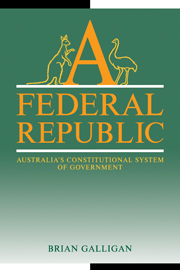Book contents
- Frontmatter
- Contents
- Tables and figures
- Preface
- Dedication
- Introduction
- 1 A federal republic
- 2 Federal theory and Australian federalism
- 3 The Senate and responsible government
- 4 Labor and the Australian Constitution
- 5 The referendum process
- 6 The protection of rights
- 7 The High Court and the Constitution
- 8 Intergovernmental relations and new federalism
- 9 Fiscal federalism
- 10 Towards and beyond 2001
- Bibliography
- Index
4 - Labor and the Australian Constitution
Published online by Cambridge University Press: 05 November 2011
- Frontmatter
- Contents
- Tables and figures
- Preface
- Dedication
- Introduction
- 1 A federal republic
- 2 Federal theory and Australian federalism
- 3 The Senate and responsible government
- 4 Labor and the Australian Constitution
- 5 The referendum process
- 6 The protection of rights
- 7 The High Court and the Constitution
- 8 Intergovernmental relations and new federalism
- 9 Fiscal federalism
- 10 Towards and beyond 2001
- Bibliography
- Index
Summary
The Australian Labor Party (ALP) was founded in the decade of the 1890s when the Australian Constitution was also being framed. These two institutions have influenced the pattern of Australian politics ever since, but they had virtually nothing in common at the beginning and remained at odds throughout much of Australia's political history. So much so that in 1957, a leading Labor spokesman and future prime minister, Gough Whitlam, summed up more than half a century of the ALP's frustrating experience as The Constitution versus Labor. As Whitlam expressed it:
the Australian Labor Party, unlike the British and New Zealand Parties, is unable to perform, and therefore finds it useless to promise, its basic policies. It has been handicapped, as they were not, by a Constitution framed in such a way as to make it difficult to carry out Labor objectives and interpreted in such a way as to make it impossible to carry them out. (Quoted in Whitlam 1977a: 16)
Labor was pledged to abolish federalism and replace it with a system in which the central government had plenary powers and the States only delegated administrative responsibilities.
In recent decades Labor has become reconciled with Australia's federal Constitution. This has occurred at two levels: formal amendment of the party platform at biennial national conferences and changes in the policy orientation of Labor governments. This chapter examines Labor's initial opposition to federalism and the process of its reconciliation during the 1960s and 1970s.
- Type
- Chapter
- Information
- A Federal RepublicAustralia's Constitutional System of Government, pp. 91 - 109Publisher: Cambridge University PressPrint publication year: 1995
- 1
- Cited by



